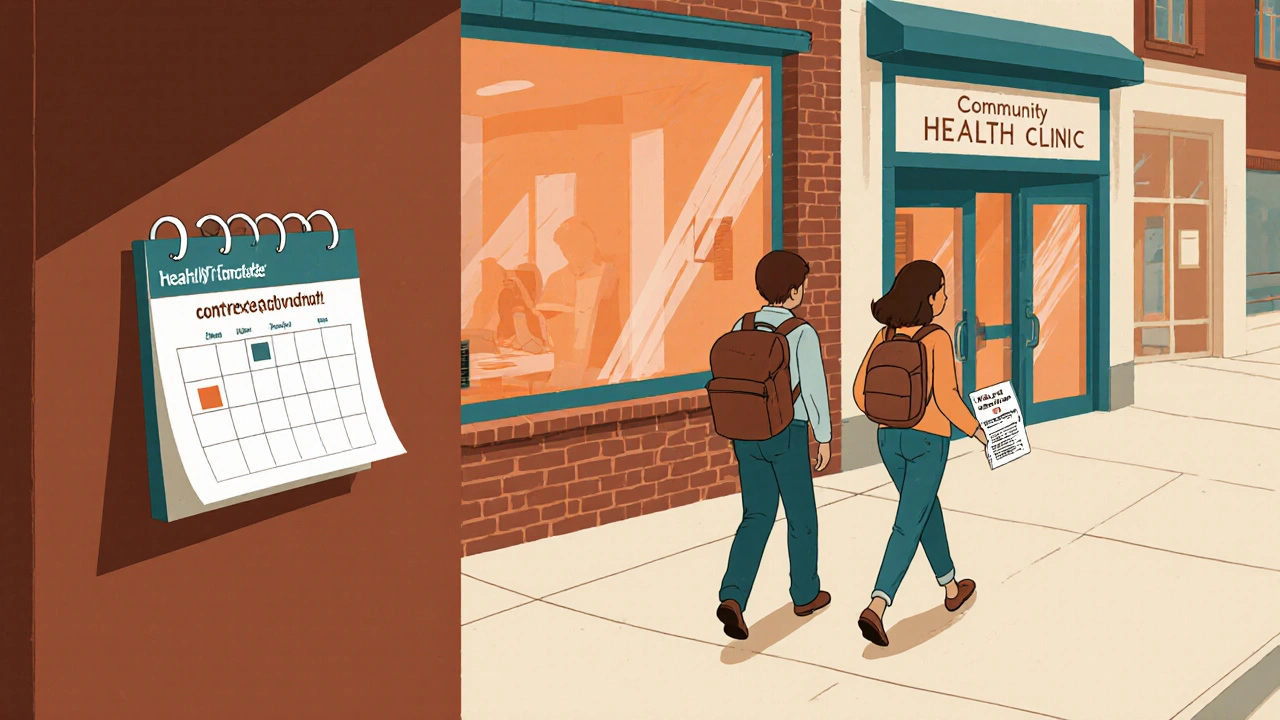How Parental Involvement Helps Prevent Unwanted Teen Pregnancies
 Oct, 21 2025
Oct, 21 2025
Parental Involvement Impact Calculator
How Your Parental Involvement Reduces Risk
Based on National Campaign research, each involvement strategy contributes to reducing teen pregnancy rates. Select the strategies you practice to see your cumulative impact.
Your Combined Impact
Select strategies to see your risk reduction
Each unit represents a reduction of 1 per 1,000 teen pregnancies.
Key Insights
Active communication provides the greatest impact (30 reduction per 1,000), while information sharing only has the smallest effect (8 reduction). Combining strategies creates cumulative protection.
When Parental involvement is defined as the active participation of parents in their teen's life, especially around health and decision‑making, the risk of unwanted pregnancy drops dramatically. Unwanted pregnancy refers to a pregnancy that occurs when a teen is not prepared-physically, emotionally, or financially-to become a parent.
Why parental involvement matters
Teenagers are at a stage where peer approval carries huge weight, but parents still shape core values. Research from the National Campaign to Prevent Teen and Unplanned Pregnancy (2024) shows that teens who report open, regular conversations with their parents about sex are 30 % less likely to experience a pregnancy before age 20. The underlying mechanism is simple: confidence, accurate information, and clear expectations reduce impulsive decisions.
Key components of effective involvement
Effective parental involvement isn’t a single action; it’s a set of habits that together create a safety net. Below are the five pillars most programs highlight.
- Accurate information sharing - Parents must know the facts about contraception methods that prevent pregnancy, from condoms to hormonal pills and convey them without judgment.
- Active listening - Teens need to feel heard. Listening without interrupting builds trust and makes future discussions easier.
- Joint decision‑making - When parents involve teens in setting personal goals, the teen sees the conversation as partnership, not policing.
- Monitoring and guidance - Knowing who the teen’s friends are and what activities they attend helps parents spot risky situations early.
- Modeling healthy relationships - Parents who demonstrate respect, consent, and communication at home set a template for their children's future relationships.
Types of parental involvement and their impact
The following table compares the most common strategies, their typical implementation, and the documented impact on pregnancy rates.
| Strategy | Typical actions | Impact on teen pregnancy (per 1,000) |
|---|---|---|
| Active communication | Monthly sit‑downs, answering questions, sharing resources | -30 |
| Joint decision‑making | Setting educational or career goals together, discussing future family plans | -25 |
| Monitoring & guidance | Knowing friends, reviewing after‑school plans, safe‑transport policies | -20 |
| Modeling healthy relationships | Demonstrating respect, equality, and consent in the household | -15 |
| Information sharing only | Handing out pamphlets, citing statistics | -8 |

Integrating sex education at home
Formal sex education curriculum that covers anatomy, consent, and contraception varies widely by school district, but parents can fill gaps. Start with the basics-what the body does, how pregnancy occurs, and why protection matters. Use age‑appropriate language; for 12‑year‑olds, stick to simple concepts, while older teens can handle discussions about STI risk and long‑term family planning.
Many parents fear that talking about sex encourages experimentation. Studies published in the Journal of Adolescent Health (2023) debunk that myth: teens who receive comprehensive information actually delay sexual debut and use contraception more consistently.
Working with schools and community programs
Partnering with school‑based programs initiatives that provide sexual health education, counseling, and access to contraception within school settings amplifies parental impact. Attend PTA meetings, ask about the curriculum, and volunteer to host informational evenings. When schools offer free condoms or the morning‑after pill, parental support for these services correlates with higher utilization rates among students.
Community family planning services that include counseling, birth‑control prescriptions, and reproductive health check‑ups centers also welcome parent participation. Some clinics run parent-teen workshops that teach both parties how to discuss contraception without shame.
Cultural and socioeconomic factors
In many cultures, talking about sex is taboo, which can hinder open dialogue. Yet research from the World Health Organization (2022) shows that when parents find culturally sensitive ways to address the topic-using faith‑based language or community elders-the protective effect remains. Socioeconomic status also plays a role: low‑income families may have less access to contraception, making parental advocacy for free resources crucial.
Practical tip: locate local REACH (Resources for Engaging Adolescents in Communities and Health) programs that subsidize condoms and provide free educational workshops. Sharing this information with your teen removes the cost barrier and signals that you’re proactive about their wellbeing.

Common pitfalls and how to avoid them
1. Assuming teens know everything. Many parents skip basics, assuming their child learned it at school. Fill the gaps yourself.
2. Using punitive language. “If you’re caught…” creates fear, not understanding. Frame conversations around protection and future goals.
3. Ignoring digital influences. Teens get a lot of information (and misinformation) online. Discuss reliable sources and teach critical thinking.
4. Waiting for a crisis. Don’t wait for a rumor or pregnancy scare. Start conversations early, before sexual activity begins.
Step‑by‑step guide for parents
- Set a regular, private time each month for health talks.
- Gather age‑appropriate resources (CDC fact sheets, Planned Parenthood guides).
- Start with the anatomy basics, then move to pregnancy mechanics and protection.
- Ask open‑ended questions: “What have you heard from friends about dating?”
- Listen without judgment, then share accurate information about contraception.
- Discuss future goals-college, career, travel-to highlight how an early pregnancy could affect them.
- Invite your teen to a local family planning clinic for a tour, even if they’re not ready to use services yet.
- Follow up: check if they have questions after the talk and adjust the next conversation based on their feedback.
Measuring success at home
Track progress with simple metrics: frequency of discussions, teen’s self‑reported comfort level, and whether they know where to obtain contraception. A quick quarterly check‑in can reveal if gaps remain.
If a teen does become pregnant, focus on supportive resources rather than blame. Connect them with counseling, health services, and educational pathways to ensure they have options.
How often should parents talk about sexual health?
Monthly check‑ins work well for most families, but increase frequency during puberty or if a teen shows curiosity or concern.
What age is appropriate to start the conversation?
Begin with basic anatomy around ages 9‑10, then layer on topics like consent, contraception, and relationships as they grow.
How can parents overcome cultural taboos?
Use culturally respectful language, involve trusted community leaders, and frame the talk around health and future wellbeing instead of “sex”.
What resources are free for low‑income families?
Planned Parenthood, local health departments, and the Title X family planning program offer free condoms, birth‑control pills, and counseling.
How do I know if my teen is ready for contraception?
Readiness isn’t about age alone. Look for signs of responsibility, ask about their knowledge, and involve a health professional for guidance.

Angela Koulouris
October 21, 2025 AT 18:43Listening without interrupting builds the trust teens need before they even think about risky choices. A simple, regular check‑in can turn a vague fear into a concrete plan, like laying down a sturdy bridge over a rushing river.
Dana Yonce
October 28, 2025 AT 16:23Keeping the talk short and sweet makes it easier for kids to remember the facts 😊. Clear language about condoms and pills cuts down on confusion.
Lolita Gaela
November 4, 2025 AT 15:03Empirical evidence from longitudinal cohort studies indicates that active parental auditory processing correlates with increased contraceptive self‑efficacy among adolescents (p < .01). By operationalizing “listening” as a structured dialogic interface, caregivers can modulate the adolescent's risk perception curve.
Giusto Madison
November 11, 2025 AT 13:43Don’t sugarcoat it-if you skip the basics your kid is flying blind in a storm of peer pressure. You have to drop the “maybe” and lay down the facts about failure rates, side‑effect profiles, and access points. When you act like a drill sergeant for health, you actually give them a weapon, not a curse. You’ll see the numbers drop faster than a bad meme.
erica fenty
November 18, 2025 AT 12:23Fact: regular talks, monitoring, and joint goal‑setting = lower teen pregnancy rates; statistics confirm it; schools love it; parents reap the benefits.
Xavier Lusky
November 25, 2025 AT 11:03All this “parental involvement” agenda is just a front for population control.
Ashok Kumar
December 2, 2025 AT 09:43Oh, sure, because every household can magically become a mini‑clinic with a bedside pamphlet and a two‑minute lecture. In reality, most parents are juggling bills, jobs, and the occasional coffee spill, not a full‑blown health curriculum.
Jasmina Redzepovic
December 9, 2025 AT 08:23Let’s be clear: the United States has the capacity to fund comprehensive family‑planning initiatives without compromising national security. The myth that “parents are too busy” ignores the data from the Department of Health showing a 22 % reduction in teen births when community outreach programs are integrated into existing school curricula. It’s a matter of policy prioritization, not personal laziness.
Esther Olabisi
December 16, 2025 AT 07:03Let’s rally together, share free resources, and keep the conversation rolling – the future is brighter when we all chip in! 🌟💪